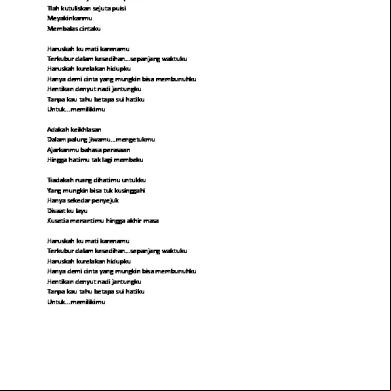Respiration In Plant 2h72u
This document was ed by and they confirmed that they have the permission to share it. If you are author or own the copyright of this book, please report to us by using this report form. Report 445h4w
Overview 1s532p
& View Respiration In Plant as PDF for free.
More details 6h715l
- Words: 467
- Pages: 25
Respiration In Plants
Energy requirement in plants • The energy requirement for living processes of plants is lower compared to animals. Why?
Because plants are less active than animals. Plants do not move about like animal do.
The Intake Of Oxygen By Plants For Respiration • Plants do not have specialised breathing mechanisms for gaseous exchange. • Gaseous exchange between plants cells and the environment occurs by diffusion through stomata and lenticels.
stomata
lenticels
Gaseous exchange in the light • When the leaf is photosynthesising, CO2 concentration ↑ in the air spaces of the spongy layer. (what will happen?) O2 diffuses from the atmosphere through stomata into the leaf for cell respiration.
Gaseous exchange in the dark • Respiration alone is taking place. < O2 in the air spaces than atm. O2 diffuses inward though lenticels. Stomata are normally closed at night.
CO2 will diffuse outwards.
Aerobic & Anaerobic Respiration in Plants.
C6H12O6 + 6O2
6CO2 + 6H2O + Energy 2880 kJ / m
Aerobic @ Anaerobic ? C6H12O6
2C2H5OH + 2CO2 + Energy
210 kJ / m
Aerobic respiration in plants
Anaerobic respiration in plants • Yeast respires anaerobically to produce alcohol (alcoholic fermentation). • During flooding, plants can survive for several days completely submerged in water. • Young rice plants are planted in fields that are muddy and flooded. • During initial stages of germination, embryo is completely enclosed within an airtight seed coat.
Respiration & Photosynthesis • Respiration is the reverse of photosynthesis.
Compare & Contrast Respiration & Photosynthesis Respiration
Photosynthesis
Similarities • Both take place in living cells. • Both are metabolic process.
Differences
Respiration
Photosynthesis
A process of A process of catabolism (breaking anabolism down of organic (synthesis of organic materials) materials) Occurs in cells Occurs in all living containing cells chlorophyll. Take place in the Takes place only in presence / absence the presence of light of light
Respiration
Photosynthesis
Uses glucose and oxygen
Uses carbon dioxide and water
Produces carbon dioxide and water
Produces glucose and oxygen
Respiration
Photosynthesis
Chemical energy is converted into heat and energy ATP.
Solar energy is converted into chemical energy
Cell loses weight
Cell gains weight
CO2 concentrations in air around plants throughout the day
CO2
Day
O2
O2
night
CO2
Compensation point
O2
Light intensity
CO2
All the CO2 produced during respiration is reused during photosynthesis
The Compensation Point
The light intensity at which the rate of carbon dioxide production during respiration is equal to that of carbon dioxide consumption during photosynthesis.
If the rate of photosynthesis and the rate of respiration remained at compensation point:
• The plant would not be able to store food. • There would be no growth and development in green plants. • No oxygen released into the atmosphere to sustain living things.
Energy requirement in plants • The energy requirement for living processes of plants is lower compared to animals. Why?
Because plants are less active than animals. Plants do not move about like animal do.
The Intake Of Oxygen By Plants For Respiration • Plants do not have specialised breathing mechanisms for gaseous exchange. • Gaseous exchange between plants cells and the environment occurs by diffusion through stomata and lenticels.
stomata
lenticels
Gaseous exchange in the light • When the leaf is photosynthesising, CO2 concentration ↑ in the air spaces of the spongy layer. (what will happen?) O2 diffuses from the atmosphere through stomata into the leaf for cell respiration.
Gaseous exchange in the dark • Respiration alone is taking place. < O2 in the air spaces than atm. O2 diffuses inward though lenticels. Stomata are normally closed at night.
CO2 will diffuse outwards.
Aerobic & Anaerobic Respiration in Plants.
C6H12O6 + 6O2
6CO2 + 6H2O + Energy 2880 kJ / m
Aerobic @ Anaerobic ? C6H12O6
2C2H5OH + 2CO2 + Energy
210 kJ / m
Aerobic respiration in plants
Anaerobic respiration in plants • Yeast respires anaerobically to produce alcohol (alcoholic fermentation). • During flooding, plants can survive for several days completely submerged in water. • Young rice plants are planted in fields that are muddy and flooded. • During initial stages of germination, embryo is completely enclosed within an airtight seed coat.
Respiration & Photosynthesis • Respiration is the reverse of photosynthesis.
Compare & Contrast Respiration & Photosynthesis Respiration
Photosynthesis
Similarities • Both take place in living cells. • Both are metabolic process.
Differences
Respiration
Photosynthesis
A process of A process of catabolism (breaking anabolism down of organic (synthesis of organic materials) materials) Occurs in cells Occurs in all living containing cells chlorophyll. Take place in the Takes place only in presence / absence the presence of light of light
Respiration
Photosynthesis
Uses glucose and oxygen
Uses carbon dioxide and water
Produces carbon dioxide and water
Produces glucose and oxygen
Respiration
Photosynthesis
Chemical energy is converted into heat and energy ATP.
Solar energy is converted into chemical energy
Cell loses weight
Cell gains weight
CO2 concentrations in air around plants throughout the day
CO2
Day
O2
O2
night
CO2
Compensation point
O2
Light intensity
CO2
All the CO2 produced during respiration is reused during photosynthesis
The Compensation Point
The light intensity at which the rate of carbon dioxide production during respiration is equal to that of carbon dioxide consumption during photosynthesis.
If the rate of photosynthesis and the rate of respiration remained at compensation point:
• The plant would not be able to store food. • There would be no growth and development in green plants. • No oxygen released into the atmosphere to sustain living things.










